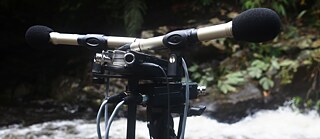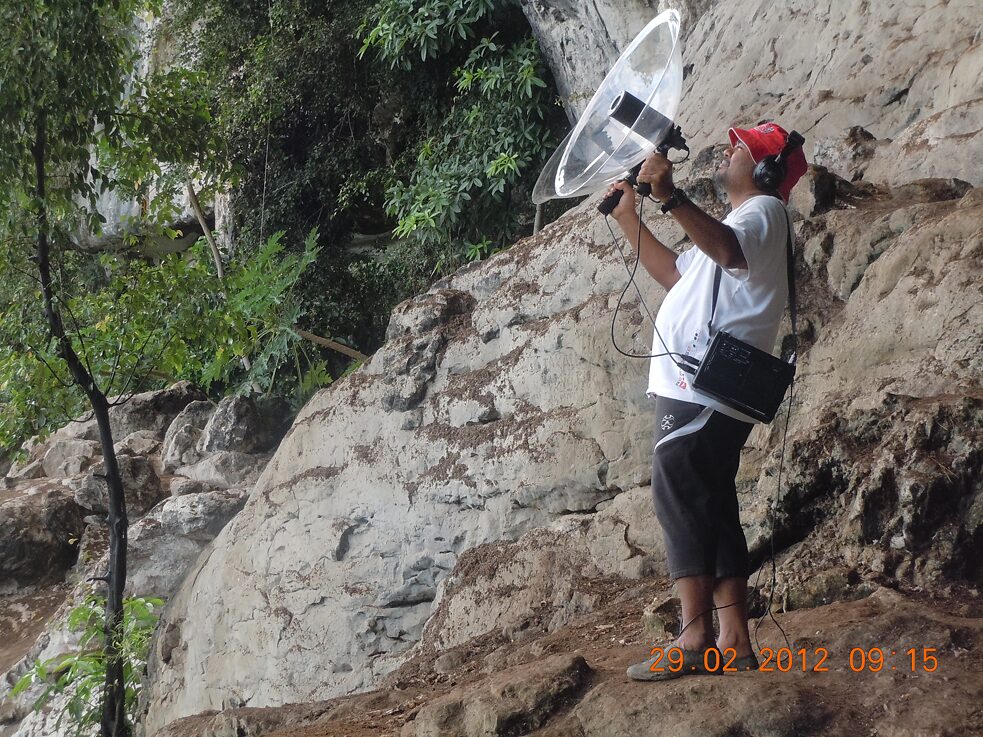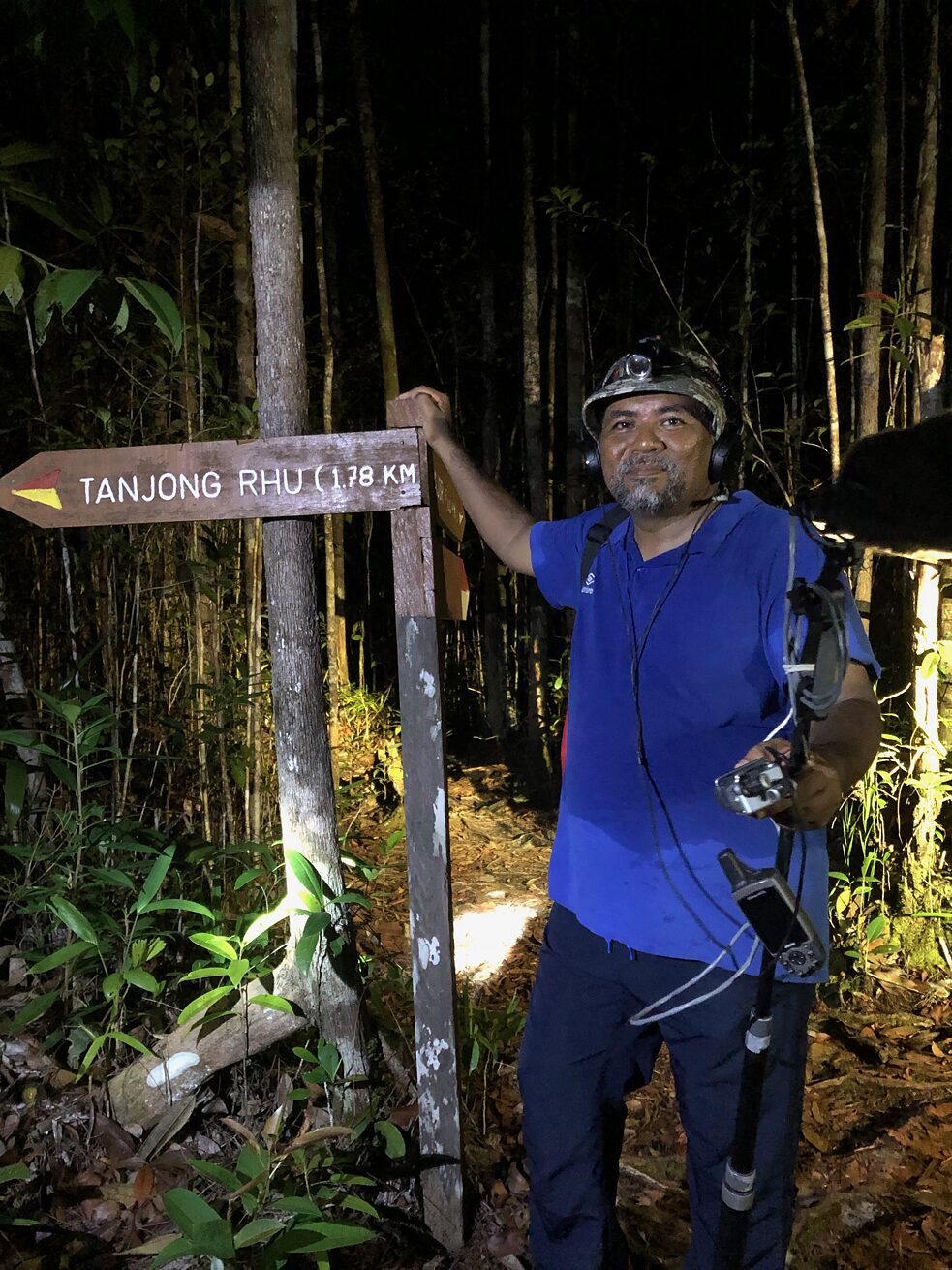
Sound as the Subject and Object of Musical Creation
By Hasnizam Abdul Wahid, 2022Nusasonic has been trying to expand its research to aural histories and sound cultures outside of major cities, to further add nuance and complexity to questions of nation, region, and representation in Southeast Asia. As a counterpoint to the Nusasonic radio episode produced by Kok Siew Wai and KLEX that featured artists from in and around the Malaysian capital Kuala Lumpur, we invited Kuching-based academic, composer, and sound artist Hasnizam Abdul Wahid to contribute a text from his vantage point in Malaysian Borneo. Hasnizam's text takes off from a previous essay published by this prolific sound researcher, titled »Sound Art in Malaysia from a Malaysian Sound Artist Perspective.« That personal and historical account of sound art and experimental music scenes in Malaysia and their connections to other strands of practice, particularly digital and new media art, forms the starting point for this new commission. From his background in computer music and the Western avant-garde, Hasnizam begins with technological considerations in sound art before sharing his current practice intertwined with ecopolitics, which takes advantage of the lush Bornean jungles just on the borders of Kuching.
Throughout my experience as a musician, I have always been attracted to the distorted sound produced by the electric guitar, mainly when playing rock music. The use of guitar effects such as distortion, chorus, reverb, and flanging has always excited me. I’ve always believed that there is something meaningful behind every sound that is heard.
In 1992 I experimented with a gamelan ensemble and electric guitar, which was rarely explored at that time. The low drone and the vibration from the brass are indeed fascinating and sometimes soothing, and this is further enhanced by the use of slendro and pelog scales.
My venture into sounds deepened after joining Band Tanpa Elektrik, or BTL for short, an ensemble consisting of various non-pitched and pitched percussion instruments of different sizes, with a repertoire consisting mostly of Malaysian popular songs.
Growing up in a rainforest environment, I was always fascinated by what I heard around me. The sounds of birds, cicadas, and wildlife immersed me in surroundings naturally composed by various musics from nature. The rainforest is indeed a sound laboratory at its best, a luxury that may not be enjoyed if you are in an urban area.
Understanding the phenomenon of sound is quite challenging for someone who is not exposed to the science of sound extensively. It is somewhat technical, and at the same time, exciting. For example, understanding theoretical concepts such as digital signal processing is not an obligation, but it will give numerous advantages when one intends to produce works or musical performances with complex interactive concepts.
I generally refer to electroacoustic music as what have been practiced by pioneering composers as the practice of composing predominantly with recorded sound., Where sound is recorded either in analogue or digital, followed by editing that leads to compositional processes. All of these creative techniques have become increasingly friendly and easy in the digital world as long as you are well equipped with essential software and hardware.
Suppose we are looking for early examples of practices that use found sound as material for musical composition. In that case, we need to refer to those who were intensively involved in the production of musique concréte through magnetic tape pioneered by composers such as Pierre Schaeffer, Pierre Henry, or Edgar Varèse. These and other composers of their generation have begun to explore the creation of music that uses recorded materials as the basis of composition, later known as electroacoustic music.
From the beginning of the exploration of electroacoustic music, making sound recordings and using hardware and software as compositional tools remain the essential creation processes of this genre. The recorded material should be of very high quality and executed based on proper recording practices such as a good understanding of microphones as well as of the distance of your sound source. The notion of a good quality recording is difficult to determine precisely. However, experience and practice with your recorder and microphone, and critical listening, is a good start.
Recorded materials will require a lot of refining after the recording was made, such as filtering or other sound enhancement applications. Another factor to consider in aiming for good sound recording is stereo depth, which will make the recorded sound more aurally convincing, and should thus be aurally analyzed through high-quality headphones or speakers.
The creative stage in composing electroacoustic music also involves the process of manipulating sound. Manipulating sound in this context means sound transformation, or producing a »new« sound from what has been recorded. The term »manipulation« or »transformation« of sound is frequently used to describe compositional processes in electroacoustic music. It is a creative process, particularly on digital platforms, used to process recorded materials to produce »new« sounds or improve the sounds that have been recorded. At the time of writing, many software applications allow users to manipulate and transform sound.
The advent of multimedia and personal computer platforms that have been enhanced with storage capabilities, fast execution rates, and affordable prices, has changed the whole perspective of the creative arts world, either in visual or sound arts. It opens a new chapter in the creative world. Backed by increasingly sophisticated software and applications, producing something creative is now not just an artist's imagination. Technology in the creative world now has able content creators to explore new dimensions of creativity, either sonic or visual.The exploration of technology also resulted in technological advancement in the entertainment industry and made creative content increasingly desirable and profitable.
Some reflection through musical pieces
My musical work, titled »Fatihah,«(2001) has evolved from my interest in the intensive use of computer technology, especially in accomplishing sound transformation. This piece is based on several recorded materials, such as the sound of balloons being pulled and blown, a garbage basket, and several sound recordings from the rainforest. It is a manifestation of elementary sound transformation in my electroacoustic music composition. It starts with a soft gesture and produces a pitch motion resembling a flying fly and gives a sense of motion when listened to through the headphones.»Engkuromong«(2002) is a work inspired by a traditional namesake musical instrument made from bronze, often played by the Iban, one of the many ethnic groups in Sarawak, East Malaysia, on the island of Borneo. The instrument is often used at public gatherings as well as during festive celebrations and is usually played to accompany a dance. Recordings of these musical instruments were made separately during several fieldwork sessions in various locations in Sarawak. The idea of this work is to explore the sound produced by the musical instrument through the technique of stretching and my use of extreme parameters on a software named Cecelia. The work starts with a low drone sound and leads to several high frequencies, and represents the spiritual elements and sacred beliefs that these people hold. Among the challenges faced in composing this piece is the refining and blinding of the high-frequency sounds produced by the engkuromong, a musical instrument usually made from a relatively thin mixture of iron and bronze, and which produces a somewhat distorted sound. Another sound source used in realising this piece is the sementin. Also known in some literature as sementin ringgit, it is one of the typical decorations found on Iban women's clothing. It is worn from the waist to the upper half of the thighs, is usually made of silver or copper, and produces a bell-like sound when the wearer walks around.
The works I produce are primarily categorised as »aggressive« based on comments I’ve received, but I'm not very interested in classifying them in any particular stream or approach. This is because as a composer, I am more inclined to work without rules and pay attention to creativity and how recorded materials can be used. A composition such as an »Interplay« (2003), for example, is one of my attempts to convey a story about an area near the street where I lived in Birmingham long ago. It reveals my daily life routine and environment from a micro and macro sound perspective. In this work, I started by creating a sound image between the abstraction of sounds representing the »scene in place« and the dramatic elements that ultimately lead the listener to visualise the scene taking place in the piece. The piece also revealed several spontaneous recordings as I walked from my house to a butcher shop nearby, also known as the »soundwalking« method. I have introduced several key sounds interplayed by several materials between recognisable and unrecognisable sounds in this work.
The piece is also my attempt to compose music that fabricates a 3-dimensional (3D) sound. My experience of observing electroacoustic works presented on various multichannel platforms such as the Ambisonic system, BEAST, IRCAM’s setup, and other systems, has given me a lot of 3D audio listening experience. It is also a typical performance method in electroacoustic music or acousmatic music. Most of the systems mentioned used custom hardware or an audio mixer as a platform to perform via sound diffusion. This notion led to the idea of my work »Rahah« (2003-04), where I tried to create a sense of spatial listening utilising the natural reverb found in the halls of a recreation centre where the sound was recorded. The recording was made by placing a condenser microphone in the center of the badminton court while a couple of friends were playing. The reverb in the recreation centre made this work more realistic and with deep stereo depth, giving a sense of space and immersion when heard on headphones.
Conversely, »metallic« (2004) is a work produced unpredictably while working in a studio. It happened when the tray of a music stand fell off during my recording session! The stand was like any other typical music stand but with a difference; instead of the tray being a solid piece, it was made as a vertical grate that vibrated and resonated on the part of the surface where the score is placed. The sound of the tray falling and resonating was amazingly beautiful. I was fascinated by the resonance, and the vibration of the sound picked up by my Neumann microphones. In exploring it further, various techniques were used to play with the object, including plucking it and striking it with a pen, and for a moment playing it as if it is a string instrument. As I struck each »string-like« part with my fingers, the music stand vibrated, creating resonance.
Exploring local content through soundscape
One of the advantages of being in the great archipelago of Borneo is that you are in the middle of natural beauty. This is definitely exciting for those who are fond of the environment. Coupled with the diversity of cultures and lifestyles, the region is very unique and a source of inspiration to anyone who appreciates it. It is no exaggeration to say that the culture of life of native or local people is still strongly connected to the ways of life of their ancestors. This is the reason why most of the work I produce can often be associated with the culture of the local community or the local atmosphere.Truthfully, it is quite rare to have a composer or sound artist talking about soundscape composition in Malaysia. This may indicate that the richness of the equatorial rainforest in Malaysia is not getting enough attention from sound activists, or maybe among the locals the beauty and sound found in the environment of the equatorial rainforest is something common and therefore not interesting.
It is quite difficult to discuss electroacoustic music, especially soundscape music composition, in the Malaysian context. This is likely because people are more familiar with the term »experimental music« rather than specific terms within genres and sub-genres. This is also one of the reasons why it is quite difficult to identify the composers and performers of such musical works, unless we attend and witness their performances.
In recent years, I have been invited to join several fieldwork initiatives led by groups of biologists focused mainly on birds and amphibians. Bioacoustic and socio-behavioural ecology research projects on the Black-nest Swiftlet (Aerodramus Maximus), and matching phylogenetic relationships with advertisement call characteristics and vocal cord structure of the male Bornean frog (Hylarana genus), are two very significant projects in which I have participated. This cross-disciplinary research stems from the common interests of several biologists and sound artists like me. Both studies have taken me far into the interior to make sound recordings, an opportunity that I rarely wish to miss.
Between 2008 and 2011, research on matching phylogenetic relationships of advertisement call characteristics and vocal cord structure of the male Bornean frogs was proposed by a biologist. The study aimed to investigate the vocalisation, communication, and social behaviour of frogs found in one of Malaysia’s National Parks. Throughout the research process, we were allowed to record and analyse sound materials. Another similar study was also established earlier on the Black-nest Swiftlet. As with the aforementioned research on the anuran species, the objective of studying the Black-nest Swiftlet was also to investigate social behaviour and to collect and classify their calls.
In a general sense, we all know of two general frog habitats and groupings, namely those closely related to human activities and the others which are more confined to forests. Frogs are known to communicate among themselves mainly to attract each other and define their occupied territory. Their variation of calling has been used by biologists as a valuable tool in taxonomic studies. According to them, during their mating season male frogs will attract females through their noisy croak sounds which also indicate their specific species.
The »Bioacoustic and Soundscape Ecology Mapping and Digitizing Project for Added Value Tourism Attraction« is my latest project to execute sound mapping of the Bako National Park, Sarawak. Bako National Park is a popular tourist destination among foreign tourists visiting Kuching, Sarawak, due to its proximity to the city center. This research is an expansion of several research projects that have been mentioned and conducted before. The project also refers to a project pioneered by Murray Schafer and his colleagues in the late 1960s that revolved around recording a soundscape which eventually established a form of sound documentation related to changes that are taking place in the environment, where density and diversity are measured through sound.
Bioacoustics is a new terminology from the perspective of music studies particularly in Malaysia, but not for biologists. It is a field that encompasses wildlife from a sound context, and aims to understand wildlife better. It is regarded as a cross-disciplinary field between biology and acoustics, and also known as a study on the sound produced by animals in their ecological context as well as in humans-dominated contexts.
The pieces »Lockdown« (2019) and »Night Walk« (2019) were composed and realised by utilising the recorded materials from Bako National Park. The recordings represent a fraction of the microsounds produced by anurans during their vocalisation. The piece was created with a specific compositional approach that explored the recorded materials by editing large sound samples into tiny fragments.
In reflecting on the works I have produced, there is no doubt that I have a tendency to use recorded materials from the environments where I live. This is because I assume that every recorded sound carries a variety of stories and represents the atmosphere of a time and place. Quite different from visual recordings, recorded sound is able to transmit the atmosphere of the environment more effectively, even more so when presented in 3-dimensional sound or at least through good stereo depth. Apart from that, listening to recorded sound also involves the consideration of the gestural aspects and dynamics generated from sound editing and processing.

